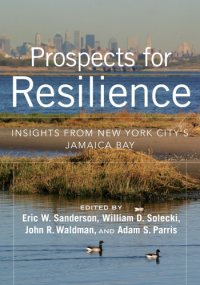
Ebook: Prospects for resilience: insights from New York City's Jamaica Bay
- Tags: BUSINESS & ECONOMICS--Industries--General, Environmentally-friendly architecture & design, Human ecology, Human ecology--United States, Regional & area planning, Renewable energy sources, Renewable energy sources--United States, Suburban life, Suburban life--United States, Sustainable development, Sustainable development--United States, The environment, Case studies, Sustainable development -- United States -- Case studies, Renewable energy sources -- United States -- Case studies, Human ecology -- United Sta
- Year: 2016
- Publisher: Island Press
- City: Atlantic Ocean;Jamaica Bay;Jamaica Bay (N.Y.);New York Region;United States
- Language: English
- epub
Foreword -- Part I: Introduction to Resilience in Jamaica Bay -- 1. Introduction: Why Prospects for Jamaica Bay -- 2. Resilience Practice in Urban Watersheds -- Part II: Social-ecological Systems of Jamaica Bay -- 3. Dynamics of the Biophysical Systems of Jamaica Bay -- 4. Change and Resilience of Jamaica Bay's Ecological Systems -- 5. Social-Ecological System Transformation in Jamaica Bay -- Part III: Tools for Resilience Practice -- 6. Resilience Indicators and Monitoring -- 7. Computational Modelling of the Jamaica Bay System -- 8. Green Infrastructure as a Climate Change Resiliency Strategy -- 9. Application of Decision Science to Resilience Management in Jamaica Bay -- 10. Building Community Resilience Practice Capacity -- Part IV: Prospects for Resilience in Jamaica Bay -- 11. Resilience Practice and Process and Product -- Glossary -- Acknowledgments -- Index.;Given the realities of climate change and sea-level rise, coastal cities around the world are struggling with questions of resilience. Resilience, at its core, is about desirable states of the urban social-ecological system and understanding how to sustain those states in an uncertain and tumultuous future. How do physical conditions, ecological processes, social objectives, human politics, and history shape the prospects for resilience? Most books set out the answer. This book sets out a process of grappling with holistic resilience from multiple perspectives, drawing on the insights and experiences of more than fifty scholars and practitioners working together to make Jamaica Bay in New York City an example for the world. This volume establishes a framework for understanding resilience practice in urban watersheds. Using Jamaica Baythe largest contiguous natural area in New York, home to millions of New Yorkers, and a hub of global air travel with John F. Kennedy International Airportthe authors demonstrate how various components of social-ecological systems interact, ranging from climatic factors to plant populations to human demographics. They also highlight essential tools for creating resilient watersheds, including monitoring and identifying system indicators; computer modeling; green infrastructure; and decision science methods. Finally, they look at the role and importance of a boundary organization like the new Science and Resilience Institute at Jamaica Bay in coordinating and facilitating resilience work, and consider significant research questions and prospects for the future of urban watersheds. The book sets forth an essential foundation of information and advice for researchers, urban planners, students and others who need to create more resilient cities that work with, not against, nature.
Download the book Prospects for resilience: insights from New York City's Jamaica Bay for free or read online
Continue reading on any device:

Last viewed books
Related books
{related-news}
Comments (0)